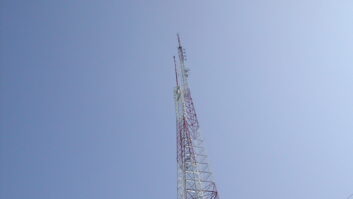In the 1800s, taverns offered free lunch to entice drinking customers. The earliest extant references to a notion that there is no free lunch date to the 1930s (serendipitously, the decade that witnessed the birth of W1XOJ, the first FM station). Milton Friedman helped popularize the idea in the 1970s.
Engineering an FM plant typically involves tradeoffs, and that is our topic of discussion.
One of our goals is to get the most bang for the buck. Sure, there is the public interest component; but the harsh reality, whether we want to admit it, is usually that the dollar is a driving force.

The FCC�s model tends to view all stations with identical contour radii as equal in coverage, but not all contours are the same. Stations with high structure density in their service areas may wish to opt for greater effective radiated power and lower height. This allows for greater effective field strength to punch through building walls. Conversely, in a more rural setting, the prudent choice may be to consider less power and more height. In such a situation, you would wind up with a larger coverage radius for listeners in vehicles but still be able to penetrate the frame construction typically utilized for building construction.
The tradeoff is one of front- versus back-end economics. A situation involving lower height and greater power may bring higher startup costs for larger transmitter, transmission line and antenna, and possibly lower initial costs for the tower due to its height, though a larger antenna may be required. Later, more power means a larger utility bill. In the converse situation, you may pay less for your box, antenna and line, and perhaps enjoy a lower power bill; but steel erection costs will spiral upwards. Expect higher long-term maintenance costs for a taller stick as well.
Nevertheless, even with a particular ERP and height, there are additional parameter changes that can be made, resulting in other tradeoffs.
For example, a single-bay antenna with really big transmitter will produce the same ERP as a 12-bay antenna and smaller transmitter. At an ERP of 50 kW, a single-bay circularly polarized antenna would require input of approximately 108 kW. Although transmission line is available to support such a set of parameters, you would be pressed to find an antenna with that power rating. At the other end of the spectrum, with a 12-bay full-wave spaced model, the input to the antenna would be around 7.3 kW. So, with a hunk of 1-5/8-inch, the plant is ready to roll.
More common scenarios involve six- or eight-bay antennas, which give an input power range of approximately 11 to 15 kW.
The 12-bay solution may seem kind of silly, but in certain circumstances it may demonstrate a brilliant tradeoff. In such a scenario, antenna and tower costs will be greater, if nothing else due to the difference in materials utilized. However, long-term benefits of a lower power bill may offset this, especially if the site is located such that vertical radiation characteristics are less important. In cases where a site is between population centers, downward radiation is less critical, given that radios tend to be a rarity among field vermin (unless of course your name happens to be Nicodemus or perhaps Mrs. Frisby).
Other tradeoffs may be required due to the mechanics of a particular site.
Spacing between bays of one wavelength is the most common antenna design. Reducing spacing will lower gain, requiring a greater input power to achieve the authorized effective radiated power. This reduction may be necessary due to structural concerns or to avoid radiofrequency radiation exposure issues at a site. This type of scenario tends to be common on mountaintops where a short tower and high ERP are utilized. While higher transmitter power may be required and the antenna may be more costly, this tradeoff may avoid lost revenue for RFR coordination, eliminate the need for a taller tower or reduce monthly rental fees.
THEORY VS. PRACTICE
Design and installation location also raise questions of tradeoffs.
For instance, on paper, a �typical� FM antenna and an antenna with a panel design will cover the same area. In reality, that is not the case.
There really is no such thing as a non-directional antenna because the environment always influences the pattern. Face size, distance from leg or face, and orientation relative to the face or leg affect the radiation pattern. Therefore, even though an antenna is considered non-directional, it is not unusual to see an effective boost in the pattern of a couple of dB along some azimuths. However, once again, there is no free lunch; other azimuths will have corresponding reductions such that the RMS of the pattern comes out close to the theoretical value for the non-D antenna.
With panel-style antennas, however, this �boost� disappears; the tower�s impact is less because of the directionality of the individual elements pointing away from the structure. I observed this when a station in the eastern part of the United States changed out a rototiller-style antenna for a panel. Although the station received numerous coverage complaints, field measurements confirmed that the antenna was performing as it was supposed to. The issue was that the beneficial effects of the tower along certain azimuths were not realized until the old antenna was modeled. In this case, the station made a tradeoff of �directional non-directional� coverage for nearly non-D coverage. Unfortunately, the population densities were sufficiently skewed geographically to actually degrade the coverage.
This same phenomenon comes into play in station upgrades, especially in the noncommercial educational world, or where commercial stations seek contour protected authorizations. If changing a facility from a non-directional to directional configuration, you must take extra care to ensure no significant audience loss. Obviously if the station is starting up with a directional antenna, there is no frame of reference. It is possible that in converting from a non-directional to a directional antenna while doubling the facility ERP, you will experience net coverage loss.
One major antenna manufacturer has a nifty utility that allows you to explore the impact that a particular tower size will have on their patterns. While it is not a substitute for actual controlled measurements, it does show that certain combinations of antennas and tower size can result in a distorted relative field of 1.5 relative to a non-directional RMS of one. The effects of the tower therefore induce a relative power of up to 2.25 along certain azimuths yielding an ERP boost of more than three dB.
FCC rules are quirky in this regard, as they ignore the contributions from the tower if the antenna is non-directional but require them to be considered if the antenna is licensed as directional. Therefore, if your antenna is directional, the maximum ERP on the license is the maximum ERP radiated at any azimuth. If licensed non-directional, it is likely the authorized value plus some more.
COVERING UP
Radomes present another tradeoff consideration. For stations where winter rarely brings anything other than liquid precipitation, radomes probably are unnecessary. Further north, they can make the difference between reliable full-power operation (and by extension full coverage) and substantial downtime. Radomes add expense, installation and maintenance considerations to an antenna purchase, but their impact is greatest in structural loading.
Traditionally, vertical real estate is based on a combination of lineal footage consumed and installation elevation above ground; a radomed antenna of a certain length results in the same revenue or rental fee, depending on your side of the equation, as its naked counterpart. Since an antenna with radomes will soak up more of the available capacity of the structure, they should garner higher rental fees. If radomes are proposed in a region of marginal utility, will the potential loss of revenue from downtime offset the added costs? On the flip side, if you were the landlord, would the use of radomes by a tenant unnecessarily preclude future revenue streams?
The minutiae of antenna tradeoffs go beyond what we have covered, but we have proved a quintessential snippet of wisdom. Perhaps the intersection of philosophy and technical stuff is one of the main reasons that we dig playing with radio so much. I�ll mull that one over lunch and get back to you.
Ruck is the principal engineer of Jeremy Ruck and Associates, Canton, Ill.












